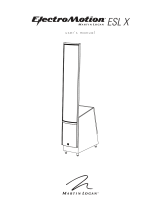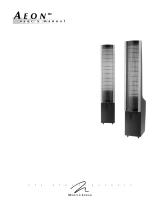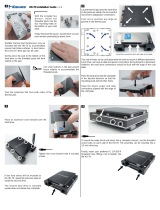Page is loading ...

S TATEMENT
TM
E2
setup manual
M ARTIN L OGAN
®
the loudspeaker technology company

Contents . . . . . . . . . . . . . . . . . . . . . . . . . . . . . . . . . . . . .2
Before You Begin . . . . . . . . . . . . . . . . . . . . . . . . . . . . . .3
Master Packing List
Required Tools
Unpacking the Statement e2
Speaker Placement . . . . . . . . . . . . . . . . . . . . . . . . . . . .4
Initial Speaker Placement
The Wall Behind the Listener
The Wall Behind the Speakers
The Side Walls
Assembly . . . . . . . . . . . . . . . . . . . . . . . . . . . . . . . . . . . . .5
Subwoofer Tower Assembly
Transition/ESL Tower Assembly . . . . . . . . . . . . . . . . . .10
Connections—Exos Crossover Inputs . . . . . . . . . . . .21
Connections—Exos Crossover Outputs . . . . . . . . . .22
Subwoofer Outputs
Full Range Outputs
Connections—ESL/Transition Towers . . . . . . . . . . . .23
Bi-Wire Connection
Horizontal Passive Bi-Amplification
Vertical Passive Bi-Amplification . . . . . . . . . . . . . . . . .24
Connections—Subwoofer Towers . . . . . . . . . . . . . . .25
8-Ohm Connection
2-Ohm Connection
4-Ohm Bi-Amp Connection
Passive Hi-Pass Settings . . . . . . . . . . . . . . . . . . . . . . .26
The High-Pass Settings
AC Power Connection . . . . . . . . . . . . . . . . . . . . . . . . .28
Making It Work Together . . . . . . . . . . . . . . . . . . . . . .29
Making It Work Together (Part 1)
Subwoofer Level Knob
Setting the Dip Switches
Making It Work Together (Part 2) . . . . . . . . . . . . . . . . .30
Speaker Placement (Fine Tuning) . . . . . . . . . . . . . . . .31
Hard Sound
Tweaking the Room
2 Contents
CONTENTS

Before You Begin 3
Master Packing List Required Tools
Before you being setting up the Statement e2, please make
sure that all 15 crates/boxes are present and accounted
for. The list below gives a detailed description of what can
be found in each numbered crate/box.
# Contents
Sub (Left)
1 Master Sub, Left
2 Middle Sub, Left
3 Middle Sub, Left
4 Top Sub, Left
Sub (Right)
5 Master Sub, Right
6 Middle Sub, Right
7 Middle Sub, Right
8 Top Sub, Right
ESL/Transition Towers
9 Trim & Sub Harness x 2
10 ESL Towers x 2
11 Transition Towers x 2
12 Instruction Box (Hardware, tools, etc.)
Base (Left)
13 Base Assembly, Left
Base (Right)
14 Bass Assembly, Right
EXOS
15 EXOS Electronic Crossover
Provided (in crate 12):
—
9
/16
” Socket
—
7
/32” Hex head
—Ratcheting screwdriver
—Grill cloth tool
You will need to provide:
—#2 Phillips head screwdriver
—Small standard screwdriver
—Level
—Cordless drill with a #2 phillips head bit
Not required, but useful:
—
1
/4
” Drive ratchet with extension
—
1
/4
” Open end wrench
—Cotton gloves
Unpacking the Statement E2
WARNING! Unpacking the Statement Evolution
2 electrostatic speaker system requires a minimum
of two people. Do not attempt any part of the
unpacking process with one person.
1 Using a power drill and a #2 Phillips head drill bit,
remove the screws from the tops of all crates. Remove
the top of each crate and set it aside, preferably in
another room.
2 Unpack the contents of the 4 left sub crates near the
front left corner of the room. Remove the crates from
the room.
3 Unpack the contents of the 4 right sub crates near the
front right corner of the room. Remove the crates from
the room.
4 Unpack the contents of the 4 ESL/Transition tower crates
in an out of the way spot in the room. Remove the
crates from the room.
5 Unpack the contents of the left base crate near the
left side of the room approximately 7 feet from the
front wall. Remove the crates from the room.
6 Unpack the contents of the right base crate near the
right side of the room approximately 7 feet from the
front wall. Remove the crates from the room.
BEFORE YOU BEGIN

4 Speaker Placement
For optimal performance of the Statement e2 system we
recommend that the ESL/Transition towers be placed
approximately five to seven feet from the front wall (the
wall in front of the listening position) and at least two feet
from the side walls. The subwoofer towers should be
placed diagonally (or against a wall) in the front corners of
the room with at least one foot of clearance between the
woofers and the walls. The listening position should be
farther than the distance between the speakers them-
selves. What you are trying to attain is the impression of
good center imaging and stage width (see figure 1).
There is no exact distance between speakers and listener,
but there is a relationship. In long rooms, naturally, that
relationship changes. The distance between the speakers
will be far less than the distance from you to the speaker
system. However, in a wide room, you will still find that if
the distance from the listener to the speakers becomes
smaller than the distance between the speakers themselves,
the image will no longer focus in the center.
Near-field reflections can occur from your back wall, the
wall behind the listening position. If your listening position
is close to the back wall, these reflections can cause problems
and confuse the quality of imaging. Actually it is better for
the wall behind you to be soft rather than bright. If you
have a hard back wall and your listening position is close
to it, experiment with devices that will soften and absorb
information (i.e., wall hangings and possibly even sound
absorbing panels).
The Wall Behind the Speakers
The front surface, the wall behind your speakers, should not
be extremely hard or soft. For instance, a pane of glass
will cause reflections, brightness and confused imaging.
Curtains, drapery and objects such as bookshelves can
be placed along the wall to soften a hard surface. A standard
sheet rock or textured wall is generally an adequate
surface if the rest of the room is not too bright and hard.
Sometimes walls can be too soft. If the entire front wall
consists of only heavy drapery, your system can sound too
soft or dull. You may hear dull, muted music with little
ambience. Harder room surfaces will actually help in this case.
The front surface should, optimally, be one long wall
without any doors or openings. If you have openings, the
reflection and bass characteristics from one channel to the
other can be different.
The Side Walls
The same requirements exist for side walls. Additionally, a
good rule of thumb is to have the side walls as far away
from the speaker sides as possible, minimizing near-field
side wall reflections. Sometimes, if the system is bright or
the imaging is not to your liking, and the side walls are
very near, try putting curtains or softening material directly
to the edge of each speaker. An ideal side wall, however,
is no side wall at all.
Initial Speaker Placement The Wall Behind the Listener
SPEAKER PLACEMENT
Figure 1. Initial Speaker Placement.

Assembly 5
WARNING! Assembling the Statement e2
requires two people, except for step 12 of the
subwoofer tower assembly, which requires three
people. Do not attempt any part of the assembly
process with one person.
1 Place the primary subwoofer module in position on the
floor, (the primary module has 10 binding posts). Corner
placement is recommended—it is important to place
the sub towers as close to final position as possible, as the
final assembled tower weighs approximately 500 lb.
However, for assembly you must leave enough space
to have access to all sides of the sub tower. Place a level
in position as shown to level the module left to right.
Adjust the glider pads on the bottom of the cabinet to
achieve level.
2 Position the level as shown to level the primary mod-
ule front to back, adjusting the glider pads on the
bottom of the cabinet to achieve level.
3 Pick up a secondary module with an assembler on each
end and place carefully onto the primary module by
lining up the cone feet on the secondary with the
indentations at each corner of the primary module.
Use your index finger as shown to feel when the cone
feet are in position.
ASSEMBLY
Subwoofer Tower Assembly
Figure 2
Figure 3
Figure 4

6 Assembly
4 After the second module is in position atop the primary
module, place a level on it as shown. Level the module
front to back by inserting a small allen wrench (or other
suitable instrument) through the hole in the cones on
the base of the module (detail), and rotating the cone
up or down to achieve level.
5 Level the module left to right with the level in position
as shown. Adjust the cone feet for height.
6 Once the secondary module is level, install the stainless
steel Martin-Logan logo plates. You have a choice of
using either a blue or red backing behind the logo—
the vinyl insert is two-sided. Peel the protective plastic
from the insert and position the insert between the
logo plate and line up with the mounting holes on the
top and bottom of the sub modules as shown. Insert
the
3
/8”-16 x 1” button head cap screws—do not
tighten until all 4 screws are started, and then tighten
in a cross-pattern so that all screws tighten down
together. Use a
7
/32” allen wrench.
Figure 5
Figure 6
Figure 7

Assembly 7
7 Stack the next secondary module atop the second uti-
lizing the same assembly procedure used in step 3.
8 Align the cones to the indentations on the cabinet
below, and level the module front-to-back and left-to-
right, following the same procedure used in steps 4
and 5.
9 Repeat the procedure in step 6.
Figure 8
Figure 9
Figure 10

8 Assembly
10 Place the fourth and final module in position (repeat-
ing steps 3 thru 6). The top module is distinguished
from the other modules by the lack of mounting holes
on the top bracket (as shown).
11 Align the slots on the top and bottom of the grill cloth
frames with the curved extrusion on the module. Place
firmly into position so that the velcro fasteners are
securely meshed.
Figure 11
Figure 12

Assembly 9
12 Install woofer wiring harness as shown. You can move the
tower to the preferred listening position by shifting
the unit from side to side and “walking” it.
13 When you are confident the sub tower is correctly
positioned, mark the floor with masking tape at each
corner. Install the spikes by using a safe dolly to tip the
sub tower back,
remove the glides, and then screw the
spikes into place.
Make sure you thread the large
black rubber washer onto the spike post before
installing in the tower. Place the tower in a vertical
position, and level front to back by tilting the tower
back (at least 3 people are required) and adjusting the
spikes.
Figure 13
Figure 14

10 Assembly
Note: The following instructions describe the assembly of
the right channel high-and mid-frequency tower. Duplicate
all assembly instructions for the left tower assembly.
1 Attach the outside (semi-circle shaped) trim rail to the
transition tower by aligning the five pins on the trim
rail with the 5 cam holes in the tower.
2 Use a phillips head screwdriver to rotate the cams a little
over 180° counter clockwise once the pin is properly
aligned in the cam. The arrow on the cam must be in
the position shown to accept the pin.
3 Make sure the trim rail is flush with the tower edge.
Transition/Electrostatic Tower Assembly
Figure 15
Figure 16
Figure 17

Assembly 11
4 Install the inside wing (wedge shaped with pins on the
side) trim rail by aligning the 5 pins with the corre-
sponding cams as in the previous assembly, only this
time the cams turn clockwise to lock in the trim wing.
5 Finished transition tower assembly.
Figure 18
Figure 19

12 Assembly
6 Pick up the transition tower assembly and insert it as
shown into the base so the three holes in the mounting
bracket line up with the holes in the tower.
7 Push the tower towards the center for proper align-
ment.
8 Once the holes are properly aligned, insert the 3
1
/2” x
9
/16” hex head lag screws through a steel washer and
into the tower. Finger tighten—do not tighten all the way.
Figure 20
Figure 21
Figure 22

Assembly 13
9 Use a level to bring the tower 90 degrees vertical left
to right.
10 When the tower is perfectly plumb, go ahead and
tighten the bolts securely.
11 Use your level to plumb the tower front to back.
Figure 23
Figure 24
Figure 25

14 Assembly
12 Tighten tower wing bolt.
13 Tighten base bolts.
14 Connect the tower as shown (red to red, black to black).
Figure 26
Figure 27
Figure 28

Assembly 15
15 Install the ESL wing trim (wedge shaped with pins on
the narrow end) by aligning the 5 pins with the corre-
sponding cams. The cams turn clockwise to lock the
trim with in place.
16 Insert the electrostatic panel as shown.
17 Line up holes and insert the 2
1
/4” x
9
/16” button head
cap screws (black) through a steel washer and into the
tower. Finger tighten.
Figure 30
Figure 29
Figure 31

16 Assembly
18 Use a level to plumb the electrostatic panel left-to-
right.
19 Measure the space between towers (top and bottom).
The space should measure exactly 2 inches.
20 Tighten frame bolts as shown.
Figure 32
Figure 33
Figure 34

Assembly 17
21 Use a level to plumb the electrostatic panel front-to-
back.
22 Tighten wing bolts.
23 Tighten base bolts.
Figure 35
Figure 36
Figure 37

18 Assembly
24 Connect light bar
25 Connect electrostatic panel wires to the color-coded
screw-terminal connector.
26 ESL panel properly connected.
Figure 38
Figure 39
Figure 40

Assembly 19
27 Find the loops at the top of the transition tower grill
sock.
28 Hook the loops as indicated at the top of the tower.
29 Hook the loops on the bottom of the sock on the
bottom of the tower as indicated.
Figure 41
Figure 42
Figure 43

20 Assembly
30 Push the grill sock into the slot provided to stretch the
cloth taut, from top to bottom.
31 Place the top of the base into position.
Note: You may want to wait before installing the top
of the base as settings inside the base may need changing.
Figure 44
Figure 45
/












